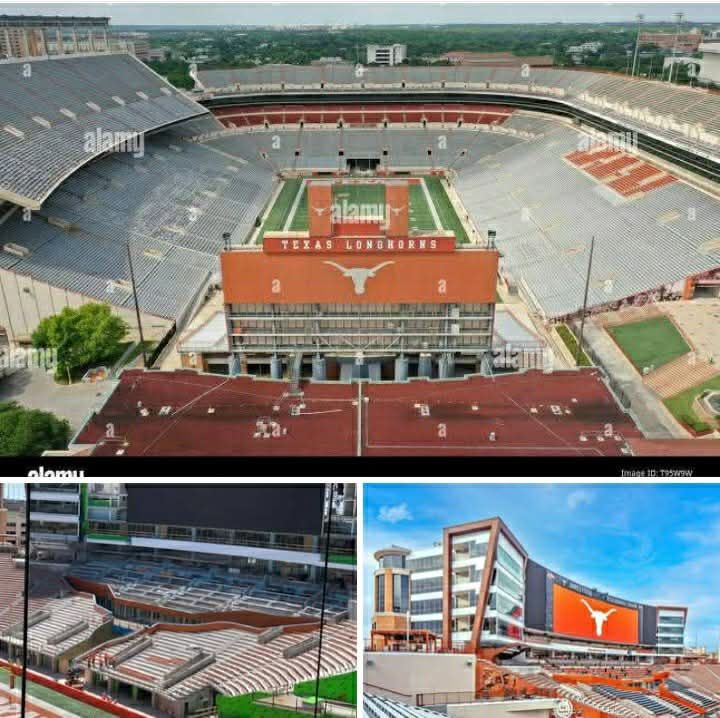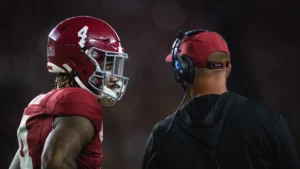
Breaking: Texas Longhorns unveil a state-of-the-art, $1.3 billion renovation to Darrell K. Royal Texas Memorial Stadium, redefining the standard for college football with luxury suites, expanded seating, and cutting-edge technology for an unparalleled fan experience.
In a bold move that reshapes the landscape of college football, the University of Texas has announced a monumental $1.3 billion renovation of Darrell K. Royal-Texas Memorial Stadium. With an ambitious vision centered on innovation, luxury, and fan-first technology, the Longhorns are setting a new standard for collegiate athletic facilities—one that mirrors the prestige and power of the university’s brand.
The renovation project, which is the most expensive of its kind in college sports history, will transform the iconic Austin venue into an elite, futuristic arena—one that blurs the lines between collegiate tradition and professional spectacle. Featuring expanded seating, high-end luxury suites, smart stadium infrastructure, and immersive experiences, the upgraded DKR Memorial Stadium aims to deliver an unmatched game-day environment for fans, players, and recruits alike.
The University of Texas has never been shy about asserting its place at the pinnacle of college athletics. The program’s entry into the SEC—college football’s most dominant conference—has only heightened the stakes. The $1.3 billion overhaul of DKR is not just a facility upgrade; it’s a statement of intent.
“This renovation is about more than football,” said Texas Athletic Director Chris Del Conte. “It’s about delivering a world-class experience to our fans, honoring our traditions, and creating a home field that stands alone in college sports.”
Del Conte and university officials emphasized that the project is funded through a mix of private donations, premium seating revenue, and long-term naming rights deals. They also noted that the decision to go big—very big—was made with a long-term competitive vision in mind.
Among the most jaw-dropping features are the stadium’s new luxury suites and premium clubs. The renovation introduces:
- Skyline Suites: 40 glass-walled, climate-controlled boxes perched high above the field, offering panoramic views of both the game and downtown Austin. Each suite includes private dining, concierge service, and customized interior decor.
- Field-Level VIP Clubs: Fans can now enjoy the game from ground level, separated from the sideline only by a low partition. These clubs feature all-inclusive food and beverage service, direct access to players’ tunnel views, and private lounges with curated art displays and multimedia features.
- Longhorn Legends Lounge: A members-only space honoring Texas football icons, adorned with memorabilia and interactive exhibits. It’s part museum, part luxury bar—an homage to the program’s past in a thoroughly modern setting.
The stadium’s overall seating will expand from approximately 100,119 to over 112,000, making it the largest stadium in the SEC upon completion. But it’s not just about more seats—it’s about better seats. The redesign features:
- Ergonomic, wider seating with cup holders and more legroom throughout the bowl.
- Family-friendly sections with children’s play zones and shaded comfort areas.
- Noise-enhancing architecture to maximize crowd impact on the field.
In partnership with tech giants including Cisco and Dell Technologies, Texas is rolling out a smart stadium ecosystem:
- 5G and Wi-Fi 7 capability throughout the venue for lightning-fast connectivity.
- Augmented Reality (AR) experiences accessible via mobile app—including real-time player stats, instant replays, and in-seat merchandise ordering.
- Smart ticketing and entry with facial recognition and app-based access to eliminate lines and delays.
The goal? A frictionless experience that gives every fan the feeling of a VIP.
4. Sustainability and Innovation
Texas has also pledged that the stadium will be LEED Platinum certified, making it one of the most environmentally conscious sports venues in the world. Among its sustainable features:
- Solar-paneled roofing structures that power key facilities.
- Rainwater harvesting systems for irrigation and restrooms.
- Zero waste targets through comprehensive recycling and composting programs.
University President Jay Hartzell noted, “Our commitment to sustainability goes hand-in-hand with our mission of excellence. We want this stadium to reflect the values and future of the University of Texas.”
While the new DKR Memorial Stadium looks forward, it does not forget its roots. Several historic design elements are being preserved and reimagined, including:
- The iconic “Longhorn silhouette” towers, which will be lit in burnt orange every time Texas scores.
- The War Memorial Plaza, now relocated and redesigned with interactive digital kiosks detailing the history of UT alumni who served in the armed forces.
- Statues and murals celebrating legendary Longhorns like Earl Campbell, Vince Young, and Ricky Williams, placed strategically throughout the concourses.
Architects behind the renovation, the globally renowned Populous firm, said the goal was to blend “iconography with innovation.”
It’s no secret that facilities play a pivotal role in recruiting, and Texas is leveraging this upgrade to full advantage. The university has already started using virtual reality tours of the planned stadium in presentations to top recruits, and the buzz has been electric.
“This is the best of the best,” said one 5-star recruit after touring the site earlier this month. “It feels like the NFL, but bigger.”
In the high-stakes world of the SEC—where programs like Alabama, Georgia, and LSU have invested heavily in infrastructure—Texas is now a clear frontrunner. The new DKR gives the Longhorns a showpiece to match their ambition and recruiting reach.
The full renovation is scheduled to be completed in stages over the next five years, with key upgrades ready for the 2026 season. Notable phases include:
- 2025: Completion of new end-zone bowl expansion and fan concourses.
- 2026: Opening of all luxury suites, AR tech integration, and new food courts.
- 2027: Full launch of VIP club experiences and sustainability systems.
Despite the extensive construction, Texas officials guarantee that no home games will be relocated. “We’re managing the process carefully to ensure fans can continue to support the team in person,” said Del Conte.
Beyond football, the renovation of DKR Memorial Stadium is expected to bring significant economic and social benefits to Austin and the university community. Estimates suggest:
- Over 8,000 construction jobs will be created during the project’s lifecycle.
- Local businesses and vendors will see increased partnerships for food, merchandise, and services.
- Event versatility will grow, with the stadium becoming a premier venue for concerts, community events, and high school championships.
Mayor Kirk Watson hailed the move as “a monumental investment in Austin’s culture, economy, and future.”
As expected, Longhorn Nation has responded with enthusiasm—and high expectations.
“Texas has always been big,” said alum and season ticket holder Denise Ortega. “But this is next level. I’ve been coming to games since the ’80s, and I never imagined I’d see something like this.”
On social media, fans trended hashtags like #DKR2Billion, #NewHomeOfTheHorns, and #BiggestInTexas, celebrating what they see as a new golden age for the program.
Ultimately, the $1.3 billion renovation of Darrell K. Royal-Texas Memorial Stadium isn’t just about facilities. It’s about identity. It’s about power, pride, and permanence. It’s about the message Texas is sending to college football, to recruits, and to its own fanbase: the Longhorns are here to dominate—not just on the field, but in every facet of the sport.
As Head Coach Steve Sarkisian put it: “We’re not just building a stadium. We’re building a legacy.”
With construction now underway, the countdown begins to what could be the most awe-inspiring football cathedral in America. And fittingly, it’s right in the heart of Texas.





